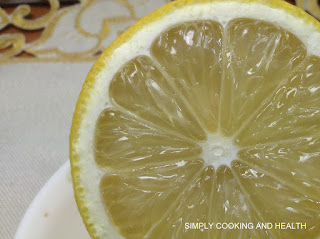 |
| Vegetables (Alkalizing food) |
We are what we eat. Our food choices affect our health. If we eat more meat, poultry, fish and eggs, our body will have more acidity. If we eat more fruits and vegetable, our body will be more alkaline. We do not need to avoid anything altogether. We need only to balance or diet to be healthy.
Acidic foods deplete oxygen that your body cells need. Acidic foods damage the mitochondria—the cells’ energy centers; and render them unable to perform vital functions. Unless excessive acids are eliminated or neutralized they will accumulate in the body and cause damage to brain cells and other cells. Excessive levels of acidity, produce a good breeding ground for bad bacteria.
Excess acidity depletes the alkaline minerals in the body especially calcium from bones and magnesium from muscles. Excessive acidity overburdens the eliminating organs like kidneys and the liver.Acids in the urine and blood will cause conditions like gout. Oh! one more thing ... cancer loves acidic environment.
To overcome an acidic condition, consume more alkaline-forming foods and then it is not necessary to eliminate acid forming foods; because the alkaline foods will neutralize the acidity in the body. It should be noted that some acid forming foods are very nutritious. If we totally eliminate acid forming foods we will miss out on the valuable nutrition they provide.
Besides you may also encounter constipation and bloating, lack of energy, weight problems, poor complexion and dry, dull skin, gum disease, frequent colds and flu, and muscle and joint pains.
As a general rule your plate should contain 80% alkaline food and 20% acidic food. This proportion will keep your body healthy.
In a scale of 0 to 14, a pH of 0 is highly acidic, 7 is considered neutral, and a 14 is considered highly alkaline. Under normal conditions, the body will be at a pH of 7.365. If the pH of your body is altered by a small amount, from 7.365 to 7, you could end up with blood poisoning.
Acidic foods deplete oxygen that your body cells need. Acidic foods damage the mitochondria—the cells’ energy centers; and render them unable to perform vital functions. Unless excessive acids are eliminated or neutralized they will accumulate in the body and cause damage to brain cells and other cells. Excessive levels of acidity, produce a good breeding ground for bad bacteria.
Excess acidity depletes the alkaline minerals in the body especially calcium from bones and magnesium from muscles. Excessive acidity overburdens the eliminating organs like kidneys and the liver.Acids in the urine and blood will cause conditions like gout. Oh! one more thing ... cancer loves acidic environment.
To overcome an acidic condition, consume more alkaline-forming foods and then it is not necessary to eliminate acid forming foods; because the alkaline foods will neutralize the acidity in the body. It should be noted that some acid forming foods are very nutritious. If we totally eliminate acid forming foods we will miss out on the valuable nutrition they provide.
Besides you may also encounter constipation and bloating, lack of energy, weight problems, poor complexion and dry, dull skin, gum disease, frequent colds and flu, and muscle and joint pains.
As a general rule your plate should contain 80% alkaline food and 20% acidic food. This proportion will keep your body healthy.
In a scale of 0 to 14, a pH of 0 is highly acidic, 7 is considered neutral, and a 14 is considered highly alkaline. Under normal conditions, the body will be at a pH of 7.365. If the pH of your body is altered by a small amount, from 7.365 to 7, you could end up with blood poisoning.
Even a mild acidity (acidosis) can lead to may problems. A
blood pH of 6.9, which is only marginally high, may result in coma or death. It
can cause cardiovascular damage, obesity, diabetes, kidney dysfunction and
kidney stones. It may also result in immune deficiency, increase in free
radicals, cancers, hormone deficiency and so on. Osteoporosis, weakening of
bones, joint pain, aching muscles and lactic acid build-up can result from
acidity of the body. Higher acidity also leads to fatigue, low energy, slow
digestion and elimination and growth of yeast and fungus. High acidity may
decrease the body's ability to absorb minerals and other nutrients, decrease
the energy production in the cells, decrease it's ability to repair damaged
cells, decrease it's ability to detoxify heavy metals, make tumor cells
thrive, and make it more susceptible to fatigue and illness.
The stomach will always be acidic because of the
hydrochloric acid produced by our body. The hydrochloric acid helps to break
down the food cells so that the food can be digested by the body. The stomach
will normally be at a lower pH of 1.35 to 3.50.
Acidosis is said to occur when arterial pH falls below 7.35.
Alkalosis occurs at a pH over 7.45. Arterial blood gas analysis and other tests
are required to separate the main causes.
Ketones are acidic. Build-up of ketones in the body can lead
to a condition known as diabetic ketoacidosis (DKA). If ketoacidosis is not
treated as soon as it is detected, it may become a life-threatening situation
for the patient.
There are two types of acidosis: respiratory acidosis and
metabolic acidosis.
Respiratory acidosis is due to excessive carbon dioxide (an
acid) being in the body. This type of acidosis is usually caused when the body
is unable to remove enough carbon dioxide through breathing. Respiratory
acidosis may be due to: chest deformities, such as kyphosis, chest injuries, chest muscle weakness, chronic lung
disease and overuse of sedative drugs
Metabolic acidosis may be due to the body producing too much
acid. It can also occur when the kidneys cannot remove enough acid from the
body. Metabolic acidosis includes diabetic acidosis, hyperchloremic acidosis
and lactic acidosis.
1. Diabetic
acidosis (also called diabetic ketoacidosis and DKA) develops when
substances called ketene bodies (which
are acidic) build up during uncontrolled diabetes. Diabetic acidosis (also
called diabetic ketoacidosis and DKA) develops when ketone bodies (which are
acidic) build up during uncontrolled diabetes.
2. Hyperchloremic
acidosis is caused by the loss of too much sodium bicarbonate from the body, which
can happen with severe diarrhea. Hyperchloremic acidosis is caused by the loss
of too much sodium bicarbonate from the body, which can happen with severe diarrhea.
3. Lactic acidosis is a build-up of lactic acid.
This can be caused by: cancer, excessive
alcohol, vigorous exercising for a very long time, liver failure, low blood sugar
(hypoglycaemia), medications, such as salicylates.
Other causes of metabolic acidosis include: kidney disease, poisoning by aspirin, ethylene glycol (found
in antifreeze), or methanol and severe
dehydration
The small intestine however can be kept at higher alkaline
level by consuming alkaline food. The pH level of the body is ascertained by
acidity or alkalinity of blood and urine. pH test paper which can be bought at
any pharmacy can measure the acid /
alkaline level of the saliva and urine. It is good to check this periodically
so that you can adjust your diet to suit the readings.
When you wet the pH paper with saliva or urine, it changes
the color. Then you compare the colour of the test paper with a test chart
provided by the manufacturer of the test paper. Often shades and
indistinguishable and the readings are not very accurate. A digital meter made
for this purpose will give very accurate results. In the long run a digital
meter can be more economical if you take several readings. Dr Young recommends
this meter.
Dr Robert Young, the author of the book – "PH
Miracle" argues that by consuming alkaline food and keeping the body
alkaline one can reduce weight and improve overall health.
Generally, alkaline forming foods include: most fruits,
green vegetables, peas, beans, lentils, spices, herbs and seasonings, and seeds
and nuts.
 |
| Fruits(Alkalizing food) |
 |
| Some of the vegetables for juicing ( Juice helps to alkaize your body) |
Generally, acid forming foods include: meat, fish, poultry, eggs, grains, and legumes.
 |
| Fish (Acidifying food) |
 |
| Salmon ( Acidifying food) |
 |
| Eggs (Acidifying food) |
 |
| Chicken (Acidifying food) |
Here are some tables showing alkalizing and acidifying foods. If your body is acidic you can try alkalizing food and avoid acidifying food. This way you will be able to adjust your body pH. If your body is alkaline you do not need to do anything.
Here are some tables showing acidifying and alkalizing foods. http://www.rense.com/1.mpicons/acidalka.htm



No comments:
Post a Comment